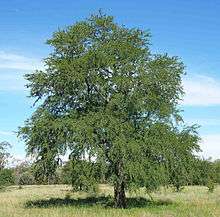Lysiphyllum hookeri
| Lysiphyllum hookeri | |
|---|---|
 | |
| habit | |
| Scientific classification | |
| Kingdom: | Plantae |
| (unranked): | Angiosperms |
| (unranked): | Eudicots |
| (unranked): | Rosids |
| Order: | Fabales |
| Family: | Fabaceae |
| Subfamily: | Caesalpinioideae |
| Tribe: | Cercideae |
| Genus: | Lysiphyllum |
| Species: | L. hookeri |
| Binomial name | |
| Lysiphyllum hookeri (F.Muell.) Pedley | |
| Synonyms | |
| |
Lysiphyllum hookeri is a species of small tree endemic to Queensland, Australia, of the legume plant family Fabaceae. These trees are known by a variety of common names, including pegunny, alibangbang, Hooker's bauhinia, white bauhinia, mountain ebony and Queensland ebony.[1][2]
Taxonomy
It, along with the rest of the genus Lysiphyllum was formerly treated as part of the genus Bauhinia.[1][3][4][5] However, recent molecular phylogenetic analysis confirms that Lysiphyllum is a distinct genus from Bauhinia.[6][7][8][9][10]
Range and habitat
These trees grow naturally in monsoon forest, littoral rainforest and occasionally in more open forest types in north-eastern Australia.[1] It has also been widely cultivated throughout Australia and the pacific region as a drought-tolerant ornamental plant.[2][11]
Description
As with most members of the genus, this species produces compound leaves with only a single pair of leaflets, producing a bi-lobed leaf that resembles the wings of a butterfly. Showy white flowers are produced throughput the year dependent on rainfall, and are accented by long red stamens. The flowers are followed by flat pods containing multiple seeds.

foliage 
flowers
References
- 1 2 3 Hyland, B. P. M.; Whiffin, T.; Zich, F. A.; et al. (Dec 2010). "Factsheet – Bauhinia hookeri". Australian Tropical Rainforest Plants. Edition 6.1, online version [RFK 6.1]. Cairns, Australia: Commonwealth Scientific and Industrial Research Organisation (CSIRO), through its Division of Plant Industry; the Centre for Australian National Biodiversity Research; the Australian Tropical Herbarium, James Cook University. Retrieved 28 May 2013.
- 1 2 Rauch FD, Weissich PR (2009). Small Trees for the Tropical Landscape: A Gardener's Guide. Honolulu, Hawaii, USA: University of Hawaiʻi Press. p. 207. ISBN 978-0824833084.
- ↑ "Bauhinia hookeri". Australian Plant Name Index (APNI), IBIS database. Centre for Plant Biodiversity Research, Australian Government. Retrieved 28 May 2013.
- ↑ "Lysiphyllum hookeri". Australian Plant Name Index (APNI), IBIS database. Centre for Plant Biodiversity Research, Australian Government. Retrieved 28 May 2013.
- ↑ Bostock PD, Holland AE, eds. (2010). Census of the Queensland Flora 2010. Brisbane: Queensland Herbarium, Department of Environment and Resource Management. p. 35. ISBN 978-1920928193. Retrieved 28 May 2013.
- ↑ "Lysiphyllum" (Online, at kew.org). Legumes of the World. London, England: Royal Botanic Gardens, Kew. Retrieved 14 May 2014.
- ↑ Bruneau A, Forest F, Herendeen PS, Klitgaard BB, Lewis GP (2001). "Phylogenetic Relationships in the Caesalpinioideae (Leguminosae) as Inferred from Chloroplast trnL Intron Sequences". Syst Bot. 26 (3): 487–514. doi:10.1043/0363-6445-26.3.487.
- ↑ Herendeen PS, Bruneau A, Lewis GP (2003). "Phylogenetic relationships in caesalpinioid legumes: a preliminary analysis based on morphological and molecular data". In Klitgaard BB, Bruneau A. Advances in Legume Systematics, Part 10: Higher Level Systematics. Royal Botanic Gardens, Kew. pp. 37–62. ISBN 1-84246-054-4.
- ↑ Bruneau A, Mercure M, Lewis GP, Herendeen PS (2008). "Phylogenetic patterns and diversification in the caesalpinioid legumes". Botany. 86 (7): 697–718. doi:10.1139/b08-058.
- ↑ Sinou C, Forest F, Lewis GP, Bruneau A (2009). "The genus Bauhinia s.l. (Leguminosae): a phylogeny based on the plastid trnL–trnF region". Botany. 87 (10): 947–960. doi:10.1139/B09-065.
- ↑ "Bauhinia hookeri (Mountain ebony)" (Online, at starrenvironmental.com). Plants of Hawaii. Hawaii: Starr Environmental. Retrieved 28 May 2013.